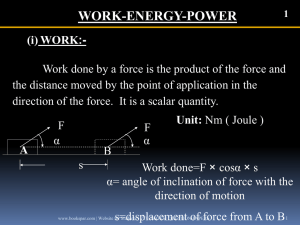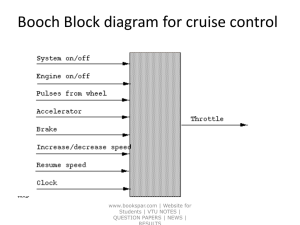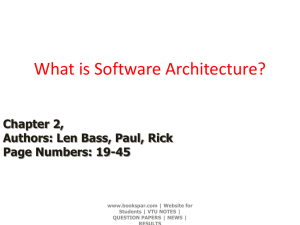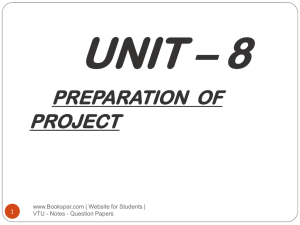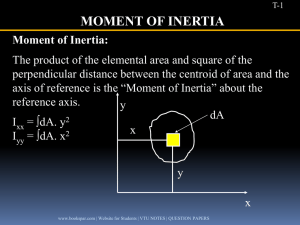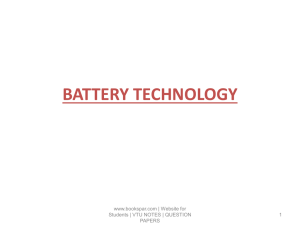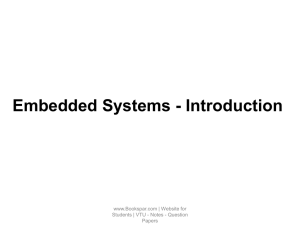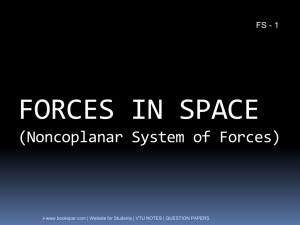SA-Unit-2-Case-studies
advertisement
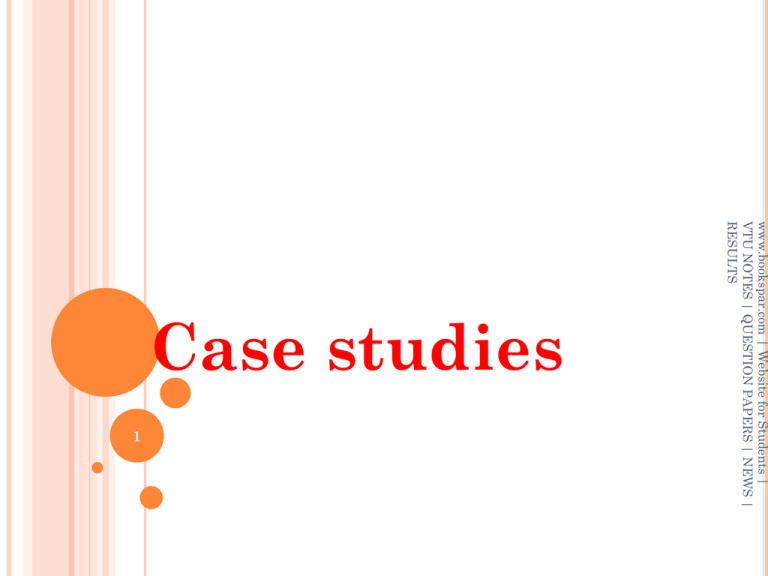
Case studies 1 www.bookspar.com | Website for Students | VTU NOTES | QUESTION PAPERS | NEWS | RESULTS Architectural styles and CASE STUDIES KeyWord In Context -KWIC Instrumentation Software Mobile Robotics Cruise Control Three vignettes in mixed style www.bookspar.com | Website for Students | VTU NOTES | QUESTION PAPERS | NEWS | RESULTS 2 KWIC www.bookspar.com | Website for Students | VTU NOTES | QUESTION PAPERS | NEWS | RESULTS 3 THE KEYWORD IN CONTEXT PROBLEM The KWIC index system accepts an ordered set of lines, each line is an ordered set of words, and each word is an ordered set of characters. Any line may be "circularly shifted" by repeatedly removing the first word and appending it at the end of the line. The KWIC index system outputs a listing of all circular shifts of all lines in alphabetical order. www.bookspar.com | Website for Students | VTU NOTES | QUESTION PAPERS | NEWS | RESULTS 4 KEYWORD IN CONTEXT DESIGN CONSIDERATIONS (KWIC): Changes in algorithm: For example, line shifting can be performed i) on each line as it is read from the input device ii) on all the lines after they are read iii) on demand when the alphabetization requires a new set of shifted lines. www.bookspar.com | Website for Students | VTU NOTES | QUESTION PAPERS | NEWS | RESULTS 5 KEYWORD IN CONTEXT (KWIC): DESIGN CONSIDERATIONS www.bookspar.com | Website for Students | VTU NOTES | QUESTION PAPERS | NEWS | RESULTS Changes in data representation: For example, lines can be stored in various ways. circular shifts can be stored explicitly or implicitly (as index and offsets). 6 KEYWORD IN CONTEXT (KWIC): DESIGN CONSIDERATIONS Enhancement to system function: Modify the system to eliminate circular shifts that starts with certain noise words (such as "a", "an", "and", etc.). Change the system to be interactive, and allow the user to delete lines from the lists. www.bookspar.com | Website for Students | VTU NOTES | QUESTION PAPERS | NEWS | RESULTS 7 KEYWORD IN CONTEXT DESIGN CONSIDERATIONS (KWIC): Performance: Both space and time. Reuse: To what extent can the components serve as reusable entities. www.bookspar.com | Website for Students | VTU NOTES | QUESTION PAPERS | NEWS | RESULTS 8 KEYWORD IN CONTEXT (KWIC): SOLUTIONS 1: Main program/subroutine with shared data. 2: Abstract data types. 3: Reactive integration. 4: Dataflow. www.bookspar.com | Website for Students | VTU NOTES | QUESTION PAPERS | NEWS | RESULTS 9 KEYWORD IN CONTEXT (KWIC): SOLUTIONS 1 (MAIN PROGRAM/SUBROUTINE WITH SHARED DATA. ) This solution decomposes the problem according to the four basic functions performed: Input: inputs and stores characters Shift which reads characters/writes index Alphabetizer: alphabetizes index Output: prints alphabetized index www.bookspar.com | Website for Students | VTU NOTES | QUESTION PAPERS | NEWS | RESULTS 10 SOLUTION 1: MAIN PROGRAM/SUBROUTINE With shared memory Master control calls www.bookspar.com | Website for Students | VTU NOTES | QUESTION PAPERS | NEWS | RESULTS Input, which inputs and stores characters Circular Shift, which reads characters/writes index Alphabetize, which alphabetizes index Output, which prints alphabetized index 11 KWIC: MAIN PROGRAM /SUBROUTINE WITH SHARED DATA SOLUTION www.bookspar.com | Website for Students | VTU NOTES | QUESTION PAPERS | NEWS | RESULTS 12 KWIC: SHARED DATA SOLUTION It decomposes the problem into 4 basic functions Input, Shift, Alphabetize, output www.bookspar.com | Website for Students | VTU NOTES | QUESTION PAPERS | NEWS | RESULTS Computational Components are coordinated as subroutines by a main program. Computations can share the same storage. This allow efficient data representation. Communication between the computational components and shared data is an unconstrained read-write protocol. ------------------- 13 www.bookspar.com | Website for Students | VTU NOTES | QUESTION PAPERS | NEWS | RESULTS --------------------------------------------------------------------- Serious drawbacks in handling changes: A change in data storage format will affect almost all of the modules. Changes in algorithm and enhancements to system function are not easily handled. Reuse is not well-supported because each module of the system is tied tightly to this particular application 14 KWIC: ABSTRACT DATA TYPES It decomposes the system into a similar set of five modules. Data is no longer directly shared by the computational components. Each module provides an interface that permits other components to access data only by invoking procedures in that interface. www.bookspar.com | Website for Students | VTU NOTES | QUESTION PAPERS | NEWS | RESULTS 15 KWIC: SOLUTION 2: ABSTRACT DATA TYPES Input Set char Char Output Word Characters Setup Set char Char Word Circular shift alph i-th www.bookspar.com | Website for Students | VTU NOTES | QUESTION PAPERS | NEWS | RESULTS Master control Alphabetic shift 16 KWIC: SOLUTION 2: ABSTRACT DATA TYPES Data encapsulated in objects Advantages Changes in algorithms and data representation in individual components don't affect other components. More reuse support. Drawbacks Changes in functionality can be difficult might involve components modification or addition www.bookspar.com | Website for Students | VTU NOTES | QUESTION PAPERS | NEWS | RESULTS is not shared anymore 17 KWIC SOLUTION 3: IMPLICIT INVOCATION Output Input Circ shift Insert Delete Lines i-th Alphabetize Insert Delete i-th Shifted lines www.bookspar.com | Website for Students | VTU NOTES | QUESTION PAPERS | NEWS | RESULTS Master control 18 KWIC SOLUTION 3: IMPLICIT INVOCATION Uses a form of component integration based on shared data similar to first solution. Interface to the data is more abstract. Computations are invoked implicitly as data is modified. An event will be sent to the shift module whenever there is new line. This allows it to produce circular shifts This causes the alphabetizer to be implicitly invoked www.bookspar.com | Website for Students | VTU NOTES | QUESTION PAPERS | NEWS | RESULTS 19 Advantages Supports functional enhancements to the system. Additional modules can be attached Supports reuse. Disadvantage: Uses more space. www.bookspar.com | Website for Students | VTU NOTES | QUESTION PAPERS | NEWS | RESULTS 20 KWIC SOLUTION 4: PIPES AND FILTERS www.bookspar.com | Website for Students | VTU NOTES | QUESTION PAPERS | NEWS | RESULTS 21 KWIC SOLUTION 4: PIPES AND FILTERS It has 4 filters : Input, shift, Alphabetize and Output. Each filter process processes the data and sends it to the next filter. Control is distributed Each filter can run whenever it has data on which to compute. Data sharing between filters is strictly limited on pipes. www.bookspar.com | Website for Students | VTU NOTES | QUESTION PAPERS | NEWS | RESULTS 22 KWIC SOLUTION 4: PIPES AND FILTERS www.bookspar.com | Website for Students | VTU NOTES | QUESTION PAPERS | NEWS | RESULTS Advantages: It maintains the sensitive flow of processing Supports reuse-each filter can function in isolation New function can easily be added to the system by inserting filters at the appropriate points. Easy to modify-each filters are logically independent Disadvantages: Virtually impossible to modify the design to support interactive system. Uses space inefficiently –since each filter must 23 copy all of the data to its output ports. COMPARISON Abstract data type Implicit invocation Pipe and filter Change in algorithm - - + + Change in data representation - + - - Change in function - - + + Performance + + - - Reuse - + - + www.bookspar.com | Website for Students | VTU NOTES | QUESTION PAPERS | NEWS | RESULTS Shared data 24 NEXT… Instrumentation Software www.bookspar.com | Website for Students | VTU NOTES | QUESTION PAPERS | NEWS | RESULTS 25
